The Temple of the Sacred Tooth Relic, known in Sri Lanka as Sri Dalada Maligawa is a place of great historic, cultural and spiritual significance.
It is located in the borders of the Udawatta Kele Sanctuary, a historic forest reserve of 104 hectares on a hill-ridge in the city of Kandy. During the days of the Kandyan kingdom, Udawattakele was known as “Uda Wasala Watta” in Sinhalese meaning “the garden above the royal palace”. The sanctuary is famous for its extensive avifauna. The reserve also contains a great variety of plant species, especially giant lianas, shrubs and small trees.
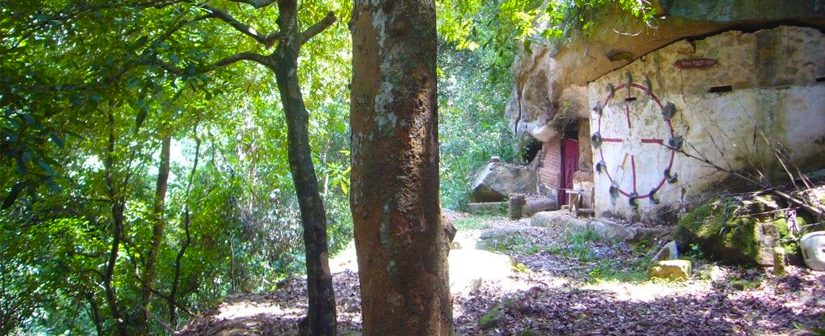
Many small and medium-sized mammals that inhabit Sri Lanka can be seen along with several kinds of snakes and other reptiles. Udawattakele was designated as a forest reserve in 1856, having become a sanctuary in 1938.
The current Temple of the Sacred Tooth Relic is at least over three centuries old and is one of the most important historical places in Sri Lanka.
The Sacred Tooth Relic
The temple enshrines relics of what is believed to be the actual tooth of Lord Buddha. After his cremation in 543 BC, the four canine teeth were taken from the ashes and were regarded as the holiest relics of Buddhism.
Of the four canines; the right canine was supposedly taken for worship by the King of Gods, another canine was taken by the king of the land Gandhara (an area which now is Pakistan), while the third was taken by the Naga tribe in Nepal (an ancient tribe who worship snakes). The final left canine was given to the King of Kalinga in East India. These canines were enshrined in funerary mounds called stupa.
The King of Kalinga in East India, Guhasiva in the 4th century AD smuggled the tooth relic to Sri Lanka with Prince Danta and Princess Hemamala in order to prevent its possession by his enemies.
The Birth of the cultural triangle in Sri Lanka
The tooth relic of Buddha was received by then King Meghavanna in Anuradhapura and enshrined in a holy edifice in the 3rd century.
With Portuguese, Dutch and the British invading Sri Lanka, and with efforts to destroy or capture the holiest tooth relic, it was moved between Kingdoms of Anuradhapura to Polonnaruwa, then to Dambadeniya and other cities such as Kotte. Upon each change, a new palace was built to enshrine the relic. Finally, it was brought to Kandy.
Now the area where the tooth was lodged is known as the cultural triangle (Anuradhapura to the north, Polonnaruwa to the east and Kandy to the south-west.)
The relic has played an important role in ancient Sri Lankan politics as it is believed that the Kingdom that holds the relic holds the governance of the country. Kandy was the last capital of the Sri Lankan kings and is a World Heritage Site, mainly due to the temple.
Who can visit?
The temple is open to Sri Lankans and foreigners. The complex can get crowded as it receives many worshippers and tourists. Backpackers, Chinese tour groups and Thai monks can often be seen jostling for space.
Opening and worship hours
The temple is open from 05.30 to 20.30. And the service times are 05.30 to 07.30, 09.30 to 11.30 and 18.30 to20.00.
On Wednesdays, there is a symbolic bathing of the sacred relic with a herbal preparation made from scented water and fragrant flowers called “Nanumura Mangalya”.
This holy water is believed to contain healing powers and it is distributed among those present.
Getting there.
Kandy, Temple of the Sacred Tooth Relic is an eight-minute walk from Kandy town around the lake. A tuk Tuk from town will cost around Rs200 to Rs250.
There are two entrances, one from the Kandy Jaffna Highway which is most likely where you’ll enter through if you decide to drive from Kandy town. The other is around the Kandy Lake on the road before you branch off to Slightly Chilled Lounge Bar and Restaurant on Anagarika Dharmapala Mawatha.
The Temple
You must always keep in mind that you’re visiting the temple that houses the holiest relic, the tooth of Lord Buddha. Hence, strict rules, body checks and procedures are followed before you will be allowed to enter the Temple of the Sacred Tooth Relic in Kandy.
What to wear.
We have a detailed knowledge base on Sri Lanka with guidelines about visiting places of worship. Even though you might be able to get away with casual attire at some places of worship, at Temple of the Sacred Tooth Relic the rules have to be followed.
Low cut or sleeveless clothing, shorts, mini skirts, Hijab, Niqab, burka, hats and shoes are not allowed. In case you’re in shorts or a mini skirt there are vendors by the gate who sell sarongs so you can cover up all that flesh.
Footwear
You’ll have to do the entire tour with no footwear. There is a designated place to keep footwear safely outside the temple and you’ll get a token number. There’s no fixed fee and on return, you could give any amount. We’d recommend between Rs50 to Rs100. This is run by the temple itself, so you shouldn’t have to worry about losing your footwear.
Fees
For passport holders of SAARC countries, Thailand and Myanmar Rs.1000, Other countries Rs1500. There are automatic ticket vending machines.
Guided tour around the temple
Freelance guides will offer their services in the entire temple complex for around Rs 600, and free audio guides are available at the ticket office. An elevator facilitates access for travellers with disabilities.
10 things to see in the Temple of the Sacred Tooth Relic
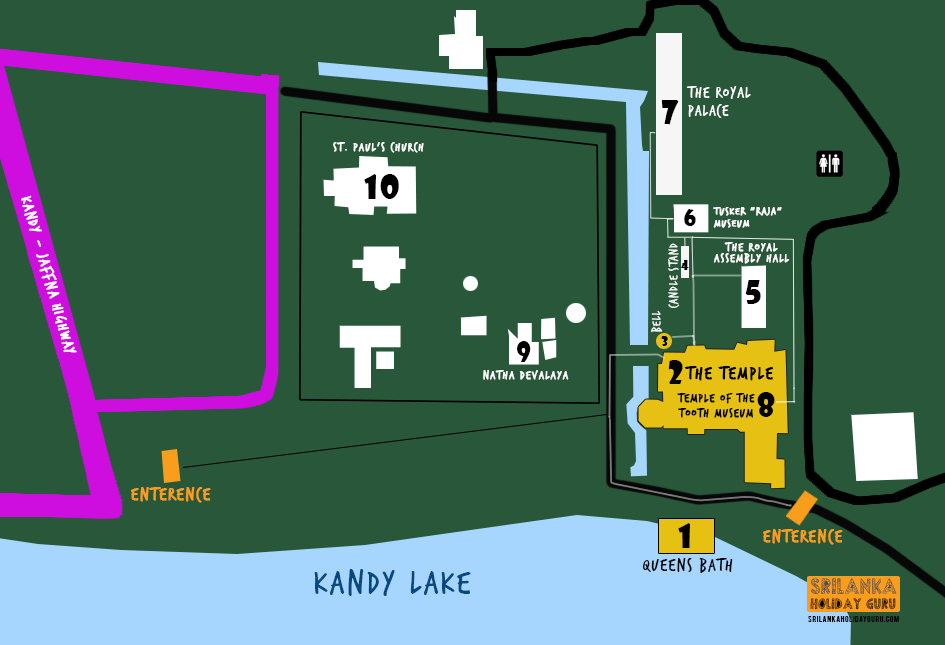
1. Queen’s Bath
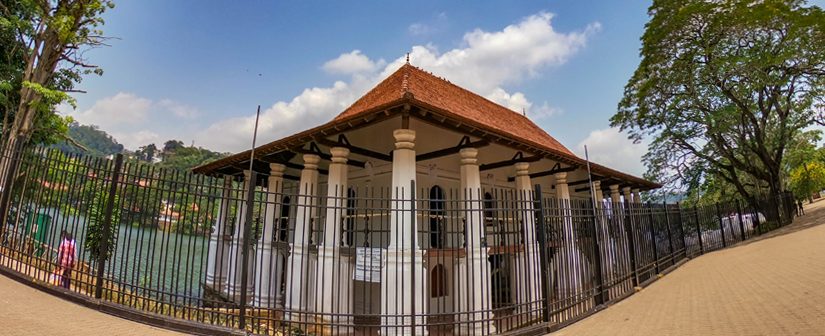
You would see this first if you enter through Anagarika Dharmapala Mawatha. The Ulpange or Queen’s Bathing Pavilion is located on the embankment of Kandy Lake, to the south of the Temple of the Tooth. It was constructed in 1806 by King Sri Wickrama Rajasinha to serve as the bathing chambers for his queen. Three sides of this two-storey building are bounded by the lake. The upper floor was used as the changing room and the ground floor was for bathing. Arches supported by columns admit sun and light to the lake at the ground level.
With the British invading the Kandyan Kingdom this was converted to a library then a police post and is now restored to as it was originally.
2. Temple of the Sacred Tooth Relic
The two storied complex houses the sacred tooth of Buddha. During worship hours the shrine that holds the tooth on the second floor is open to the public.
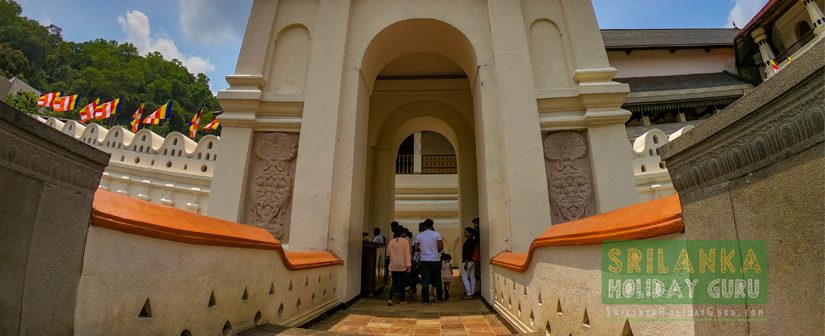
The moat filled with the water was built by King Sri Wickrama Rajasinghe as protection to the Temple of the Sacred Tooth Relic. The original drawbridge across the moat has been replaced by a concrete bridge.
At the entrance, visitors pass through Ambarawa, a tunnel-shaped hallway with paintings depicting eight men in traditional Kandyan costume. This leads to the main shrine complex, having a central courtyard surrounded by structures depicting scenes from stories.
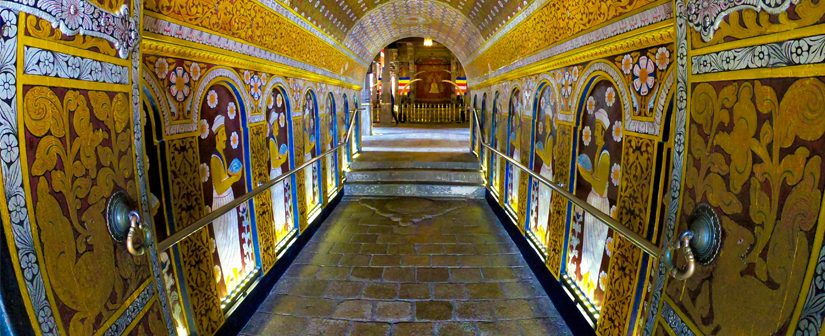
The lower hall houses the chamber where the sacred Tooth Relic was kept with utmost honour. The pride of the Temple is displayed by the figures of two lions with gaping mouths carved in stone on both sides of the flight of steps, and four large tusks.
During the daily worship hours, five kinds of traditional upcountry drums are played. The upper roof was supported by 20 carved and painted stone columns 10 each side.
On either side are the Pallemale temple constructed by King Kirti Sri Rajasimha and the Octagon built by the last king, Sri Vikrama Rajasimha. On one side the small “stupa” is supposed to contain the Bowl Relic of the Buddha.
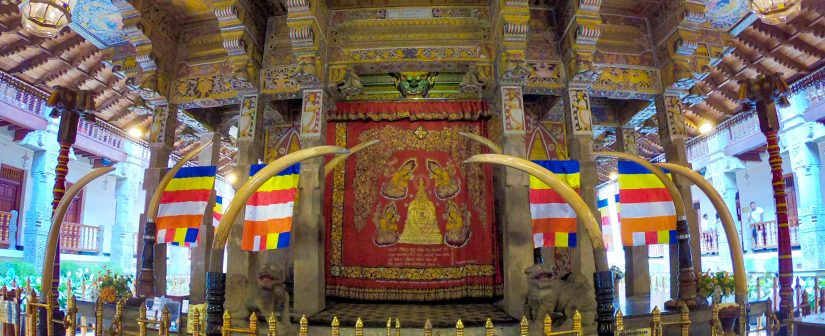
The structures to the right and left of the shrine, constitute the residence quarters of the monks engaged during daily service (Tevava), the conference hall, the library and the Office of the Diyawadana Nilame
3. The fountain and the bell
The exit door from the temple complex leads to a garden-like opening with a fountain which can be used to refresh oneself. Note: this is not drinking water. There’s purified, filtered water close to it.
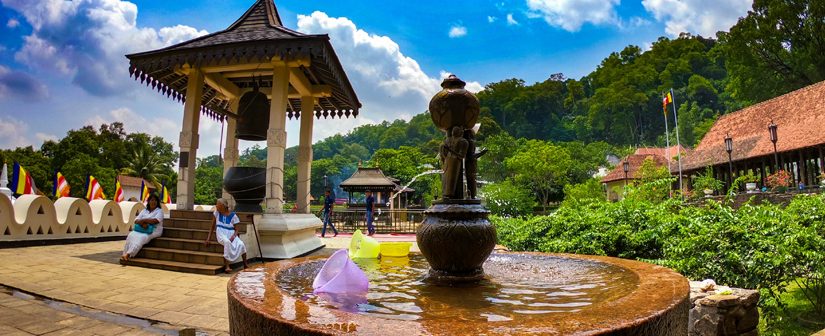
The bell in the background was donated by the government of Japan and is used as the temple bell during worship hours.
4. Lighting oil lamps
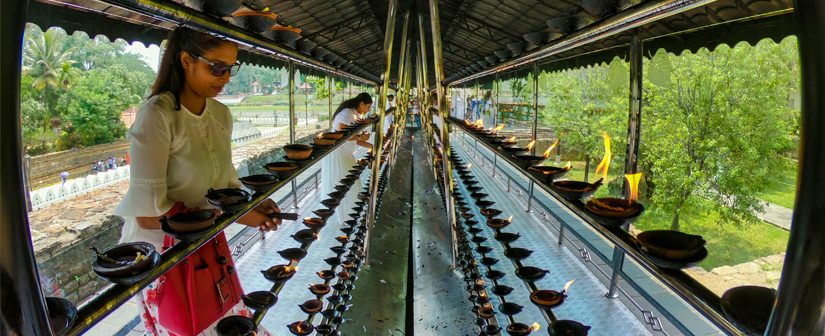
Worshipers and devotees light oil lamps. The lighting of a candle or an oil lamp represents the light of wisdom illuminating the darkness of ignorance. the burning of incense represents the fragrant scent of morality.
5. The Royal Assembly Hall
The Magul Maduwa or Royal Audience Hall is where the king met his ministers and carried out administrative tasks. The building was also known as the “Maha Naduwa” or Royal Court.
Constructed in by the Kandian King Rajadhi Rajasinghe 1783 A.D, the hall is built with 64 wooden columns decorated with 32 carvings of Lakshmi Devi, aka Goddess of wealth, and sculpture representing Kandyan Architecture.
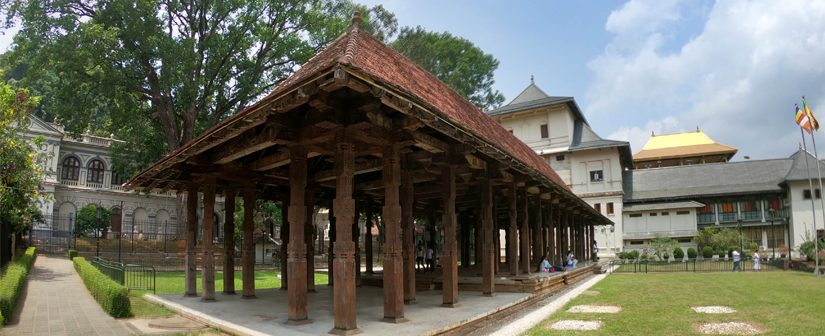
A Kandyan style roof rests upon these columns.
It was here on 5 March 1815 that the Kandyan Convention was signed between the British and the Kandyan Chieftains (Radalas) ending the Kingdom of Kandy, the last native kingdom of the island.
Visitors and devotees often could be found in mediating here
6. Tusker “Raja” Museum
This is also the palace where the king used to rest while Adigars (Chief minister and royal advisers) and other visitors awaited him. Foreign visitors were able to meet the king in this palace. It is situated near the Raja Wasala and Magul Maduwa. Today this building is used as The Tusker Raja museum.
Raja, the elephant with great tusks, carried the Sacred Relic Casket for more than half a century and. is honoured by the Dalada Maligawa by preserving the dead animal’s skin and tusks to look like the tusker when he was alive.
7. The Royal Palace
During the period of King Senarat (1603 – 1634), the Portuguese attacked the Kandyan Kingdom and destroyed the palace. Rajasinha II who ascended to the throne in 1634 rebuilt it and all the subsequent kings until 1815 (the year which the kingdom fell under British rule) used this as their Royal Palace. By the time of the last king, Sri Vickrama Rajasinha (1797 – 1814) the palace consisted of many buildings spread around the premises.
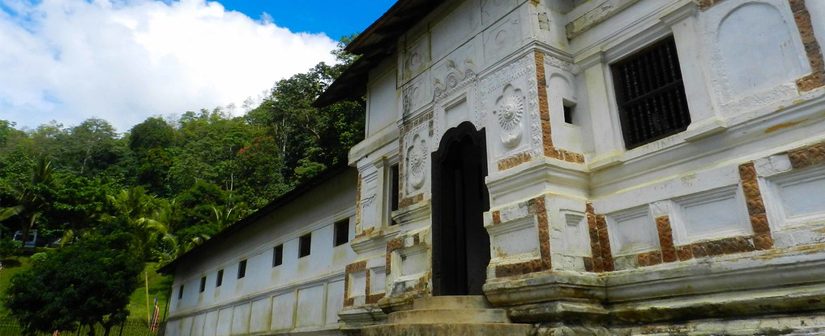
There were three gateways and 8 feet (2.4 m) high wall used as main entrances. The section of the palace facing the Natha Devale is said to be the oldest.
8. Temple of the Tooth Museum
The first floor has historical records, lists of the Chief Prelates, lists of Kandyan Kings and portrait busts, etc. The second floor has historical artefacts and religious items such as caskets, statues jewellery, etc.
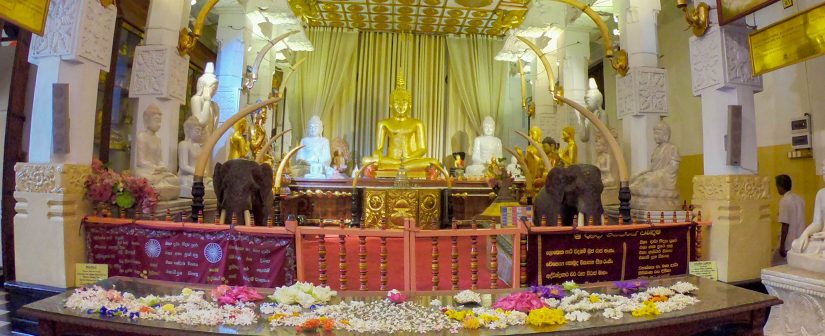
It has notable items such as a silver water pot offered by King Kirti Sri Rajasimha, silver hanging lamp offered by king Rajadhi Rajasimha, a painted replica of Buddha’s Foot Print sent by King Borom Kot of Thailand and a unique Relic Casket containing bodily relics of the great Thera Moggliputta. Also, the museum has dresses and garments of King Keerthi Sri Rajasinha including the king’s head cover, chest piece (Manthe), Karavaniya (cotton cloth worn over trousers), cotton shirt, Saravale (trousers) and handkerchief.
9. Natha Devalaya
The Nàtha Devàla is located on the terrace, in front of the Palace complex. It is said to have been in existence even before the Tooth Relic was brought to Kandy. The oldest existing structure in Kandy, it is said to have been built by King Vikramabahu III in the 14th century.
The history of the worship of God Natha is not clear. The name ‘Natha’ literally means ‘no form’ and ‘no shape’, and is therefore generally associated with Lord Maitreya, the next Buddha.
During the Kandy period, Natha was was the highest ranking deity, and then it was Vishnu, Kataragama and Patini in that order.
The building has a Dravidian architecture with a “gedige” style. The structure has three stories but the first and the second-floor levels serve no practical purpose. The roof is a dome with a shape of a stupa. The Devale has two stupas and
recent excavations have revealed a circular shape basement probably a Mandapa which has been destroyed by invaders. The stupa near the Devale is thought to contain the bowl relic of Buddha and was broken in to by Relic Hunters in 1889.
10. St. Paul’s Church
In 1825 the Bishop of Calcutta, Reginald Heber, visited Kandy with the Governor of Ceylon, Edward Barnes, to preach and conduct a confirmation service. He noted that the church services where being held in the former King of Kandy’s Royal Assembly Hall.
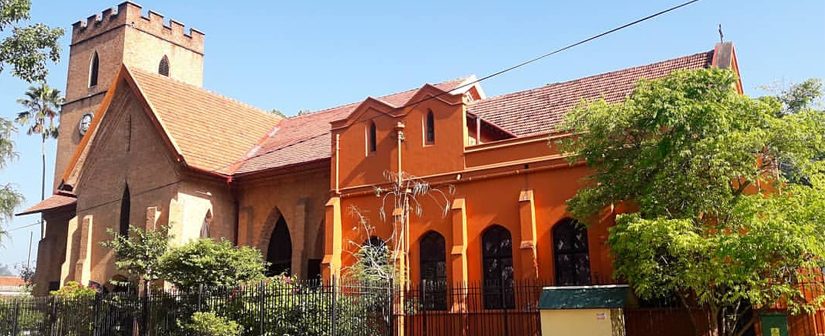
The church houses the only pipe organ in Kandy and possibly the largest pipe organ in regular use in Sri Lanka. The original pipe organ was donated in 1874 and was in constant use until 2009 when it was replaced with a similar-sized pipe organ from a disused church in Bradford, England.
Kandy Esala Perahera
The Esala Perahera in Kandy is celebrated to honour the Sacred Tooth Relic and the four ‘guardian’ Gods Natha, Vishnu, Kataragama and Goddess Pattini. The Kandy Maligawa Perahera is followed in order by those of the Natha, Vishnu, Kataragama and Pattini ‘Devales’ (Temples dedicated to these Gods) which are situated in the vicinity of the Kandy Maligawa (Temple of the Tooth).
After the Kandyan Kingdom fell to the British in 1815, the custody of the Tooth Relic was handed over to the Buddhist Clergy. In the absence of the King, a lay custodian called the Diyawadana Nilame was appointed to handle routine administrative matters. The purpose of the Kandy Esala Perahera Procession is to beseech blessings of the gods to obtain rain for the cultivation of crops and to enrich the lands of the kingdom.
This ritual is performed by carrying the sacred tooth relic of the Buddha through the streets of the Kandy and done with exceptional panache. This is considered as one of the most beautiful pageants in Asia. Usually, the Kandy Esala Perahera is celebrated in the month of July and lasts for 12 days.
Sri Lanka Holiday Guru Tip
Smoking at the Temple or its premises is not allowed.
Keep your phones and electronic devices on silent, and do not make phone calls.
The guards on duty wouldn’t mind possession of cigarettes.
Lighters and pocket knives should be left with the gate guards and collected on the way out.
Photography and videography is allowed as long as you don’t obstruct the worshippers and devotees. In doubt, you could ask the staff on duty. Avoid the use of flash.
Avoid unauthorised tour guides outside the temple. The temple has official tour guides.
Do not accept offers outside the temple to sell you tickets to enter the temple as the only way to get a ticket is through a self-ticket vending machine.




